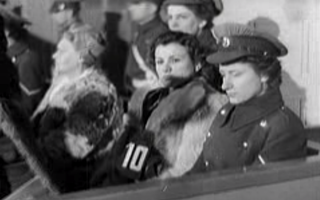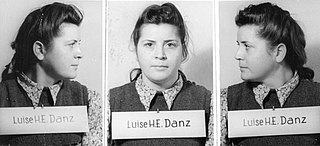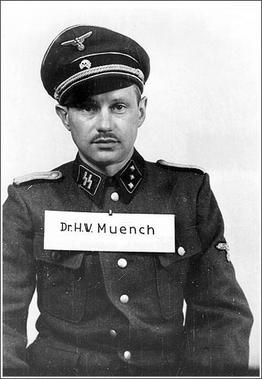
Auschwitz concentration camp was a complex of over 40 concentration and extermination camps operated by Nazi Germany in occupied Poland during World War II and the Holocaust. It consisted of Auschwitz I, the main camp (Stammlager) in Oświęcim; Auschwitz II-Birkenau, a concentration and extermination camp with gas chambers; Auschwitz III-Monowitz, a labour camp for the chemical conglomerate IG Farben; and dozens of subcamps. The camps became a major site of the Nazis' Final Solution to the Jewish question.

Irmgard Ilse Ida Grese was a Nazi concentration camp guard at Ravensbrück and Auschwitz, and served as warden of the women's section of Bergen-Belsen. She was a volunteer member of the SS.

Rudolf Franz Ferdinand Höss was a German SS officer and the commandant of the Auschwitz concentration camp. After the defeat of Nazi Germany and the end of World War II, he was convicted in Poland and executed for war crimes committed on the prisoners of the Auschwitz concentration camp and for his role in the Holocaust.

Maria Mandl was an Austrian SS-Helferin and a war criminal known for her role in the Holocaust as a top-ranking official at the Auschwitz-Birkenau extermination camp, where she is believed to have been directly complicit in the deaths of over 500,000 prisoners. She was executed for war crimes.

The Belsen trials were a series of several trials that the Allied occupation forces conducted against former officials and functionaries of Nazi Germany after the end of World War II. British Army and civilian personnel ran the trials and staffed the prosecution and judges.

The Hamburg Ravensbrück trials were seven trials for war crimes during the Holocaust against camp officials from the Ravensbrück concentration camp that the British authorities held in their occupation zone in Germany in Hamburg after the end of World War II. These trials were heard before a military tribunal; the three to five judges at these trials were British officers, assisted by a lawyer. The defendants included concentration camp personnel of all levels: SS officers, camp doctors, male guards, female guards (Aufseherinnen), and a few former prisoner-functionaries who had tortured or mistreated other inmates. In total, 38 defendants were tried in these seven trials; 21 of the defendants were women. One of the defendants died during the trial. Twenty of the defendants received death sentences. One defendant was reprieved while two others committed suicide before they could be executed. The remaining 17 death sentences relating to these trials were carried out on the gallows at Hamelin Prison by British hangman Albert Pierrepoint.

Alice Orlowski was a German concentration camp guard at several of the Nazi concentration camps in German-occupied Poland (1939-1945) during World War II. After the war, a Polish court convicted of her crimes against humanity, and she served 10 years in prison in Poland. In 1973, Orlowski, now 70 and living as a pensioner in West Germany, muttered that only "half the work" had been finished, referring to the Holocaust. She was promptly arrested, convicted of making antisemitic remarks, and sentenced to 10 months in prison.

Luise Danz was a Nazi concentration camp guard in World War II. Danz was captured in 1945 and put on trial for crimes against humanity at the Auschwitz trial in Kraków, Poland. She was sentenced to life imprisonment in 1947, but released due to general amnesty on 20 August 1957.

Georg Konrad Morgen was an SS judge and lawyer who investigated crimes committed in Nazi concentration camps. He rose to the rank of SS-Sturmbannführer (major). After the war, Morgen served as witness at several anti-Nazi trials and continued his legal career in Frankfurt.

Hans Wilhelm Münch, also known as The Good Man of Auschwitz, was a German Nazi Party member who worked as an SS physician during World War II at the Auschwitz concentration camp from 1943 to 1945 in German occupied Poland. He was acquitted of war crimes at a 1947 trial in Kraków.

Franz Hößler, also Franz Hössler was a Nazi German SS-Obersturmführer and Schutzhaftlagerführer at the Auschwitz-Birkenau, Dora-Mittelbau and Bergen-Belsen concentration camps during World War II. Captured by the Allies at the end of the war, Hößler was charged with war crimes in the First Bergen-Belsen Trial, found guilty, and sentenced to death. He was executed by hanging at Hameln Prison in 1945.
Oswald Kaduk was a German SS member during the Nazi era. He served as Rapportführer at the Auschwitz concentration camp.

Josef Klehr was an SS-Oberscharführer, supervisor in several Nazi concentration camps and head of the SS disinfection commando at Auschwitz concentration camp.

Wilhelm Friedrich Boger known as "The Tiger of Auschwitz" was a German police commissioner and concentration camp overseer. He gained infamy for the atrocities he committed at Auschwitz, including torturing prisoners using a device known as the "Boger swing."

The two Treblinka trials concerning the Treblinka extermination camp personnel began in 1964. Held at Düsseldorf in West Germany, they were the two judicial trials in a series of similar war crime trials held during the early 1960s, such as the Jerusalem Adolf Eichmann trial (1961) and the Frankfurt Auschwitz Trials (1963–65), as a result of which the general public came to realize the extent of the crimes that some two decades earlier had been perpetrated in occupied Poland by German bureaucrats and their willing executioners. In the subsequent years, separate trials dealt with personnel of the Bełżec (1963–65), Sobibor (1966), and Majdanek (1975–81) extermination camps.

Adolf Theuer was an SS-Unterscharführer at Auschwitz concentration camp. He was executed after the war as a war criminal.

The Dora Trial, also the "Dora"-Nordhausen or Dachau Dora Proceeding was a war crimes trial conducted by the United States Army in the aftermath of the collapse of the Third Reich. It took place between August 7 and December 30, 1947, on the site of the former Dachau concentration camp, Germany.

The Belzec trial in the mid-1960s was a war crimes trial of eight former SS members of Bełżec extermination camp. The trial was held at the 1st Munich District Court and should be seen in the context of the Sobibor trial, which followed the Belzec trial, because five of the defendants were accused in both trials. In addition, the Belzec and Sobibor trials, along with the Treblinka trials, form a body of evidence of the crimes of mass extermination as part of the so-called Action Reinhardt programme - the killing of over two million Jews and 50,000 Roma and Sinti. These trials are directly related to the mass murder of 100,000 people in the official Nazi Euthanasia programme known after the war as Action T4, as many of the security guards worked in the euthanasia centres before transferring to the extermination camps. The first Euthanasia trials were carried out shortly after the war.

Friedrich Karl Hermann Entress was a German camp doctor in various concentration and extermination camps during the Second World War. He conducted human medical experimentation at Auschwitz and introduced the procedure there of injecting lethal doses of phenol directly into the hearts of prisoners. He was captured by the Allies in 1945, sentenced to death at the Mauthausen-Gusen camp trials, and executed in 1947.

Stefan Baretzki was an Auschwitz guard of Bukovina German origin. He was conscripted into the Waffen-SS and stationed at the Auschwitz concentration camp from 1942 until 1945. There he participated in the mass murder by making selections, beatings and murdering prisoners on his own initiative. After the war, Baretzki settled in West Germany. He was the lowest-ranking of the twenty-four defendants in the Frankfurt Auschwitz trials. His murders were sensationalized in the German press, taking the focus off of the systematic crimes of the Nazi regime. The court sentenced him to life imprisonment and eight years for participating in the murder of more than 8,000 people. Baretzki expressed regret for his actions, testified against his former superiors, and committed suicide while serving his sentence.




















